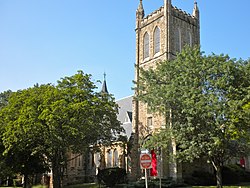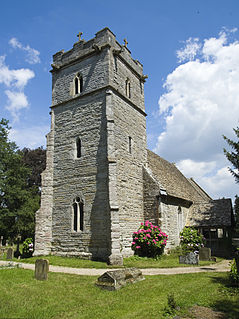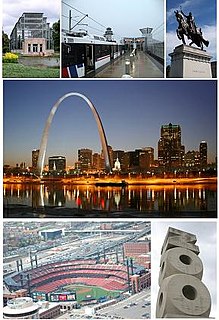
Sacred Heart Cathedral, located in Davenport, Iowa, United States, is a Catholic cathedral and a parish church in the Diocese of Davenport. The cathedral is located on a bluff overlooking the Mississippi River to the east of Downtown Davenport. It is listed on the National Register of Historic Places as part of the Sacred Heart Roman Catholic Cathedral Complex. This designation includes the church building, rectory and the former convent, which was torn down in 2012. The cathedral is adjacent to the Cork Hill Historic District, also on the National Register. Its location on Cork Hill, a section of the city settled by Irish immigrants, gives the cathedral its nickname Cork Hill Cathedral.

St. Agnes Cathedral is a Roman Catholic Cathedral in Rockville Centre, New York, on Long Island. It is the seat of the Diocese of Rockville Centre. The Most Reverend John Oliver Barres is the ordinary bishop of the Diocese and pastor of the Cathedral parish. The Saint Agnes Cathedral School is on campus with the Cathedral.

The Cathedral Basilica of Christ the King is a Roman Catholic church in Hamilton, Ontario, Canada. The cathedral was consecrated on December 19, 1933. It is the seat of the Bishop of the Diocese of Hamilton, and the cathedral of the Diocese of Hamilton. The cathedral contains the cathedra of the Bishop, the Most Rev. Douglas Crosby. The cathedral was raised to the status of a minor basilica in February 2013 by Pope Benedict XVI.
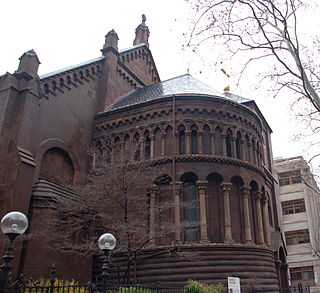
Saint Clement's Church is a historic Anglo-Catholic parish in Philadelphia. It is part of the Episcopal Diocese of Pennsylvania.

The Basilica of St. John is a Minor Basilica of the Catholic Church in the Drake neighborhood of Des Moines, Iowa, United States. It is also a parish church in the Diocese of Des Moines. The church building is listed on the National Register of Historic Places.

Our Lady, Queen of the Most Holy Rosary Cathedral is a Roman Catholic church located at 2535 Collingwood Boulevard in the Old West End of Toledo, Ohio. The cathedral is the mother church of the 122 parishes in the Roman Catholic Diocese of Toledo. This cathedral is unique architecturally in that it was designed in the Spanish Plateresque style. It was designed with Toledo's Sister City, Toledo, Spain in mind. Finished in 1931, it was built in the spirit of the great European cathedrals of the Middle Ages.
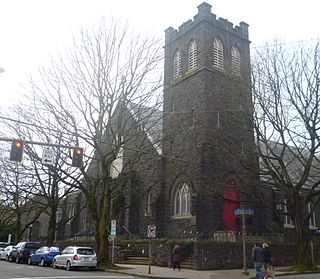
Trinity Episcopal Cathedral in Portland, Oregon is the seat of the Episcopal Diocese of Oregon of The Episcopal Church. The cathedral is located at 147 N.W. 19th Avenue in Portland, Oregon, in the Northwest District.

St. Anthony's Catholic Church is a parish church in the Diocese of Davenport. The parish complex is located in downtown Davenport, Iowa, United States, at the corner of Fourth and Main Streets. It is the first church congregation organized in the city of Davenport and the second Catholic congregation, after St. Raphael's Cathedral in Dubuque, in the state of Iowa. The parish buildings are listed on the National Register of Historic Places as St. Anthony's Roman Catholic Church Complex. The designation includes the church and the former school building, which is the parish's original church building and the oldest standing church building in Iowa. The designation also included the rectory, which was torn down in 2009. The complex was also listed on the Davenport Register of Historic Properties in 1992 as St. Anthony's Church Square. The property has been known historically as Church Square.

The Church of All Saints is a parish of the Catholic Church in the Diocese of Davenport. The church is located in Keokuk, Iowa, United States. The church building is listed on the National Register of Historic Places as St. Peter Church, the name of the congregation that built it.
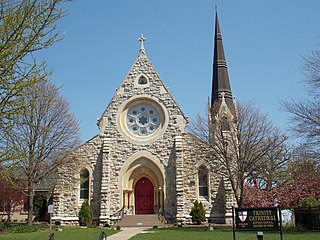
Trinity Episcopal Cathedral, formerly known as Grace Cathedral, is the historic cathedral in the Diocese of Iowa. The cathedral is located on the bluff overlooking Downtown Davenport, Iowa, United States. It is one of the oldest cathedrals in the Episcopal Church in the United States, and it was individually listed on the National Register of Historic Places in 1974. The cathedral is also a contributing property in the College Square Historic District, which is also listed on the National Register.

Saints Peter and Paul Catholic Church is a former parish church of the Diocese of Davenport. The church is located in rural Solon, Iowa, United States. The property is on a gravel road east of Iowa Highway 1 between Solon and Mount Vernon in rural Johnson County. It was listed on the National Register of Historic Places in 1999.

St. Mary of the Visitation Catholic Church is a parish of the Diocese of Davenport. The church building is located on the corner of 4th and Court Streets in downtown Ottumwa, Iowa, United States. It is part of the Central Park area, which is the civic center of the community. It includes: the Wapello County Courthouse, the Ottumwa Public Library, and the Ottumwa City Hall. The church is eligible for the National Register of Historic Places, but it has not been listed.
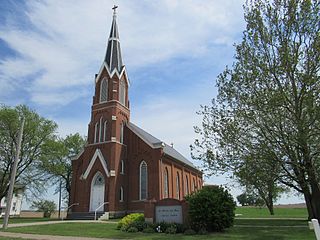
Saints Peter and Paul Roman Catholic Church is a former parish church of the Diocese of Davenport. The church is located in rural Harper, Iowa, United States, in Clear Creek Township, Keokuk County. It is listed on the National Register of Historic Places. The parish was known in the Davenport Diocese as Saints Peter and Paul, Clear Creek.

The Cathedral Church of St. Paul, is located in downtown Des Moines, Iowa, United States. It is the cathedral church of the Episcopal Diocese of Iowa. The building was listed on the National Register of Historic Places as St. Paul's Episcopal Church.
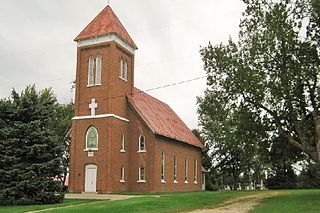
St. Joseph's Catholic Church is a former parish of the Diocese of Davenport. The church is located in Dallas township in rural Marion County, Iowa, United States. It was part of the now defunct village of Bauer. The closest communities are Melcher-Dallas and Lacona. The church building still stands and together with the adjacent cemetery comprises an historic district listed on the National Register of Historic Places.

Trinity Episcopal Church is a parish church in the Diocese of Iowa. The church is located in Muscatine, Iowa, United States. It was individually listed on the National Register of Historic Places in 1974. In 2006 it was included as a contributing property in the Downtown Commercial Historic District.

St. James Episcopal Church is a parish of the Diocese of Iowa located in Oskaloosa, Iowa, United States. It was listed on the National Register of Historic Places in 1991.

The Episcopal Church of the Atonement and Parish House is a historic church building at 5751 North Kenmore Avenue in Chicago, Illinois. The Gothic Revival building was constructed in 1889 and added to the National Register of Historic Places in 2009.

Christ Cathedral is the cathedral church for the Episcopal Diocese of Western Kansas. It is located in Salina, Kansas, United States, and has been listed on the National Register of Historic Places since 2010.

Trinity Episcopal Cathedral is an Episcopal cathedral located in Trenton, New Jersey, United States. It is the seat of the Diocese of New Jersey.
